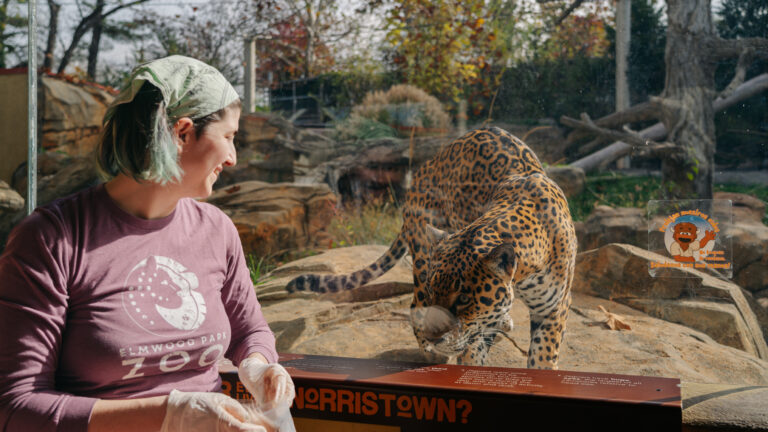By Janine Farmer, Animal Keeper
If you’ve ever visited Trail of the Jaguar and seen one of our big cats gnawing on a deer leg or an eagle tearing into a fish, you might have wondered—what exactly is a carcass feed?
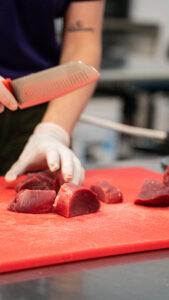 THE BASICS
THE BASICS
Technically, every carnivore that eats fish, rodents, or chicks is carcass fed. In the simplest terms, it means feeding an animal food that still resembles its original form—something that still “looks like” what it once was.
At Elmwood Park Zoo, our carnivore diets come in a few different forms: some are processed (like the ground meats many of our animals receive), and others arrive frozen in bulk (like rats for snakes or birds of prey). In the wild, these same animals would naturally catch and eat whole prey: snakes swallow rodents, eagles dive for fish, and jaguars hunt larger mammals.
Here in the Zoo, most of our animals were born in human care and never had to hunt. So it’s our job to make sure feeding time still gives them the mental and physical challenge they’d experience in the wild.
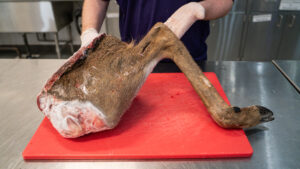 Finding Inspiration in the Trail of the Jaguar
Finding Inspiration in the Trail of the Jaguar
When I first started working in the Trail of the Jaguar three and a half years ago, I took a special interest in improving enrichment and nutrition for our cats. Every animal here has a carefully designed diet that meets their nutritional needs—but in our field, there’s always room for growth and creativity. Sometimes, the right opportunity comes along and pushes us to evolve.
For us, that opportunity came through new relationships with local hunters and the Pennsylvania Game Commission. Deer season in Montgomery County is very productive, and while hunters often take the prime cuts for themselves, there’s usually not much use for tails, bones, or organ meat.
We began to receive deer bone donations on a regular basis, and as those increased, we realized we could completely rethink how we feed our carnivores.
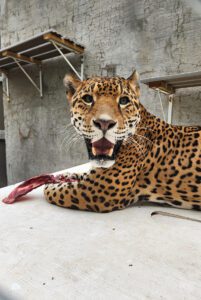 Breaking Down the “Why”
Breaking Down the “Why”
Before making any big changes, we asked ourselves the important question: Why?
Why change their diets, and why feed them such recognizable parts—like deer legs, tails, or spines—right in front of guests? There’s often a stigma around the word “carcass,” even though it’s one of the most natural things for these animals.
When people hear “carcass feed,” it might sound harsh—but when you reframe it as natural feeding or whole-prey feeding, it makes perfect sense. It’s about giving animals the chance to be animals.
The Wild Connection
Take a jaguar, for example. In the wild, they use incredible strength to bring down prey, then rely on the strongest bite force of any cat to crunch through bones, hide, and muscle. That action helps to clean their teeth and strengthen their jaws, and they receive natural fiber and nutrients from fur, hooves, and connective tissue.
We can’t fully replicate the thrill of the hunt, but we can get close. For smaller cats like Mateo the ocelot, I might hang a whole deer tail high on a climbing structure or hide it inside a puzzle feeder. Watching him work to retrieve it, plucking every bit of hair before reaching the bone underneath, is watching him be a wild cat.
For our jaguars, we get a little more inventive. Twice a week, they receive deer bones—usually from the hock to the hoof. We’ll sometimes hide one inside a large bucket and hang it from their climbing structure. Zean, our male jaguar, then has to problem-solve, climb, jump, and wrestle to get it down. By the end, he’s worked out both physically and mentally—and that’s a huge win for his overall well-being.
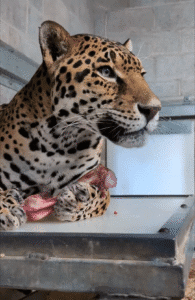 The Monthly Feast
The Monthly Feast
We also introduced monthly carcass feeds, where our jaguars get an entire deer leg—shoulder to hoof—instead of their usual meal. These are what we call gorge feeds: one big feast followed by a smaller meal the next day.
That mimics how big cats naturally eat in the wild—feast, rest, repeat. Watching Inka, our female jaguar, drag her meal to a quiet spot to guard it and enjoy it over time is as natural as it gets. She’s using her instincts, her muscles, and her mind—all at once. We can see recognizable changes in their behavior when they receive these feeds, such as more time grooming and resting when normally they might be patrolling.
More Than Just Cats
These benefits go beyond the big cats. Our commissary team helps prepare similar feeds for our birds of prey. If you’re lucky, you might spot our red-tailed hawk and turkey vulture, Hunter and Stan, enjoying a deer head, or our bald and golden eagles tackling a rib cage.
It might look intense, but it’s deeply enriching for them—and it’s a powerful educational moment for guests, too.
Why It Matters
At the end of the day, carcass feeds help our animals live their best, most natural lives. They get to think, move, and eat the way nature intended.
And for our visitors, seeing these behaviors up close builds appreciation for the incredible animals we care for and their wild instincts. The closer we can bring the wild to our Zoo, the stronger the connection we can create between people and the natural world.
Our goal is to foster a connection and appreciation for the animals in our care, and what better way than to watch a wide array of natural behaviors?
